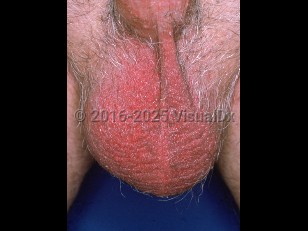Red scrotum syndrome - Anogenital in
See also in: Cellulitis DDxAlerts and Notices
Important News & Links
Synopsis

White men older than 50 have the highest incidence of this condition, but cases have been reported in younger individuals. Patients commonly present with scrotal erythema and burning pain, with some patients reporting intermittent flushing rather than persistent erythema and a minority of patients reporting itch as well. A preceding history of topical corticosteroids on the affected area is often elucidated on history, but around 60% of 38 patients in a 2025 case series did not have a history of topical corticosteroid use. When topical steroids have preceded RSS, the average duration of topical corticosteroid use is 27 months, but cases of RSS have occurred after as few as 2 weeks. RSS can develop after prolonged use of topical corticosteroids with a potency as low as over-the-counter hydrocortisone cream. A common complaint is difficulty sitting normally due to pressure on the scrotum causing pain. RSS is a chronic condition that is difficult to treat, which can cause profound psychological distress.
RSS is thought to be part of red burning skin syndrome, which describes other presentations of rebound vasodilation following chronic use of topical corticosteroids, including red face syndrome, red scalp syndrome, red ear syndrome, and red vulva syndrome. Rosacea was also seen in around 25% of individuals in the case series of 38 patients.
Codes
L53.9 – Erythematous condition, unspecified
N50.89 – Other specified disorders of the male genital organs
SNOMEDCT:
238969001 – Burning scrotum syndrome
Look For
Subscription Required
Diagnostic Pearls
Subscription Required
Differential Diagnosis & Pitfalls

Subscription Required
Best Tests
Subscription Required
Management Pearls
Subscription Required
Therapy
Subscription Required
Drug Reaction Data
Subscription Required
References
Subscription Required
Last Updated:08/16/2025

